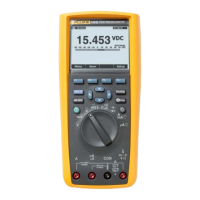189II/AN
Service Manual
4
• When measuring current, turn off circuit power before
connecting the Meter in the circuit. Remember to place the
Meter in series with the circuit.
• When making electrical connections, connect the common
test lead before connecting the live test lead; when
disconnecting, disconnect the live test lead before
disconnecting the common test lead.
• Do not use the Meter if it operates abnormally. Protection
may be impaired. When in doubt, have the Meter serviced.
• Do not operate the Meter around explosive gas, vapor, or
dust.
• Use only 1.5 V AA batteries, properly installed in the Meter
case, to power the Meter.
• When servicing the Meter, use only specified replacement
parts.
• When using probes, keep fingers behind the finger guards
on the probes.
• Only use test leads that have the same voltage, category,
and amperage ratings as the meter and that have been
approved by a safety agency.
• Use proper protective equipment, as required by local or
national authorities, when working in hazardous areas.
• Comply with local and national safety requirements when
working in hazardous locations.
WCaution
To avoid possible damage to the Meter or to the equipment
under test, follow these guidelines:
• Disconnect circuit power and discharge all high-voltage
capacitors before testing resistance, continuity, diodes, or
capacitance.
• Use the proper terminals, function, and range for all
measurements.
• Do not remove batteries while the Meter is turned on or a
signal is applied to the Meter’s input jacks.
• Before measuring current, check the Meter's fuses. (See
"Testing the Fuses" in the Users Manual on the
accompanying CD.)

